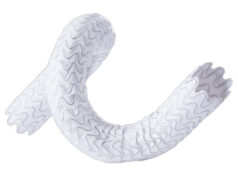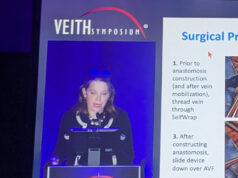The six-month results of the WAVE (WRAPSODY Arteriovenous Access Efficacy) pivotal trial have reported superior target lesion primary patency (TLPP) with the WRAPSODY (Merit Medical) cell-impermeable endoprosthesis when compared to percutaneous transluminal angioplasty (PTA) when used in failing arteriovenous fistulas (AVF). Experts note that based on these results, covered stents could potentially be a first-line treatment in dedicated lesion sites, ushering in an era of tailored therapy for dialysis patients.
The AVF arm of the prospective, multicentre trial enrolled 245 patients with AVF peripheral venous circuit outflow lesions requiring intervention from 43 international centres and was designed to assess the device’s superiority to PTA. Of this cohort, 123 patients were randomised to PTA and 122 to WRAPSODY. The trial also tested the device in patients with arteriovenous grafts, and these findings are anticipated to be released soon.
The AVF results showed that six-month patency was “significantly” higher for both TLPP (89.8% vs. 62.8%, p<0.0001) and access circuit primary patency (ACPP; 72.6% vs. 57.9%, p<0.015) in patients treated with WRAPSODY when compared with patients randomised to PTA.
A distinguished global panel moderated by Mahmood Razavi (St Joseph Heart & Vascular Center, Orange, USA), one of the WAVE trial’s principal investigators, alongside panellists comprising co-principal investigator Robert Jones (Queen Elizabeth Hospital Birmingham, Birmingham, UK) and WRAP Global Registry principal investigators Dheeraj Rajan (University of Toronto, Toronto, Canada) and Panagiotis Kitrou (Patras University Hospital, Patras, Greece) discussed the findings.
The panel noted that these were numerically the “best result that we’ve seen for any comparable device”, particularly in the context of poor historical outcomes achieved using PTA. They further reflect on the performance characteristics of the device, which was designed to overcome the mechanisms of failure of the dialysis access circuit, whether it’s negative remodeling, recoil or, tissue proliferation due to neointimal hyperplasia, and to prevent all of these to extend long-term vessel patency rates. The discussion also focused on the WRAP global registry, which is a prospective, multicentre, observational study to gain “a better understanding of how this performs in the real world”.
This video, intended for our audience in countries where WRAPSODY is CE marked, is sponsored by Merit Medical.












